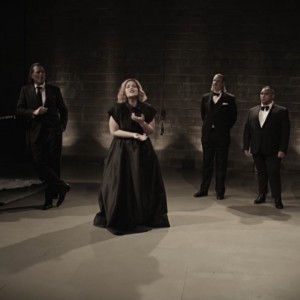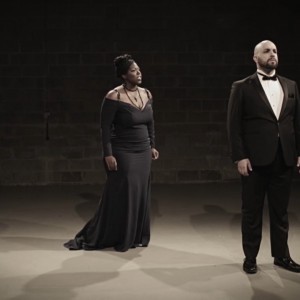Music by Umberto Giordano
Libretto by Arturo Colautti
On October 2020 Fedora was filmed at the Target Margin Theater in Brooklyn, starring soprano Michelle Johnson in the title role and tenor Jeremy Brauner in his debut as Loris. The digital production has been filmed with four cameras and a sound engineer using interactive cameras and overlaying filming techniques provided by Freedom View Contribution.
Since the pandemic hit our county it was clear that this year we would not be able to have an orchestra due to Covid-19 related restrictions. But we were resolute to produce Giordano’s masterpiece. We decided that a piano accompaniment made a better musical choice than an small orchestra ensemble. Our Music Director, Israel Gursky conducted the score from the piano.
FILM FESTIVALS
Cast & Creative Team
FEDORA | Michelle Johnson, soprano
LORIS | Jeremy Brauner, tenor
DE SIRIEX | Marcello Guzzo, baritone
OLGA | Maria Brea, soprano
DESIRÈ | Samuel White, tenor
DIMITRI | Eugenia Forteza, mezzo-soprano
GRECH | Rubin Casas, bass
LOREK | Michael Gracco. baritone
CIRILLO | Brian Montgomery, baritone
ROUVEL | Jordan Weatherston Pitts, tenor
BOROV | Rick Agster, bass
A PEASANT BOY | Kinneret Ely, soprano
SERGIO | Pavel Suliandziga, tenor
NICOLA | William Desbiens, baritone
FISARMONICA | Ezio Pelliteri
DIRECTOR | Malena Dayen
LIGHTING DESIGNER | Jon DeGaetano
ASSISTANT LIGHTING DESIGNER | Matthew Deinhart
PROJECTIONS | Sangmin Chae
EDITING | Enrico Ventrice
ASSISTANT CONDUCTOR | Nicole Russell
CONDUCTOR: Israel Gursky
FILMING LOCATION | Tagret Margin Theater, Brooklyn NY
SYNOPSIS:
Act One
Setting: A winter night, 1881. The salon of Vladimiro Andrejevich in St. Petersburg.Princess Fedora is waiting for her fiancé Vladimiro, whom she is to marry that day when a police officer and De Siriex suddenly appear carrying him in gravely in. The police officer, Inspector Gretch, questions the servants while Fedora learns that Vladimiro was found wounded in a pavillion. The pavillion had been rented by an old woman who delivered a letter to Vladimiro earlier in the day. But that letter is nowhere to be found. Fedora swears to avenge Vladimiro’s death. Suspicions turn to Loris Ipanov, a friend of the nihilists (anarchists) and whose apartment is near the place of the shooting.
Act Two
Setting: Paris Fedora follows Loris Ipanov to Paris to avenge Vladimiro. She holds a reception in her home, which Loris attends. Loris declares his love to Fedora;but, she appears to reject him and reveals her intentions to return to Russia. Having been exiled, Loris cannot return with her. Desperate, Loris admits that he killed Vladimiro. Enraged Fedora convince him to return after the reception to tell her the entire story. In the meantime, she writes a letter to Vladimiro’s father, the Russian Imperial Chief of Police, accusing Loris of the murder. Loris returns later and explains that he had caught Vladimiro having an affair with his wife. He claims shooing him in self-defense since it was Vladimiro who fired the first shot. Fedora realizes that he was defending his honor and that Vladimiro was a cad. She convinces Loris to remain with her that night.
Act Three
Setting: A villa in the Bernese Oberland, Switzerland. Loris and Fedora are happily in love. De Siriex arrives and informs Fedora that the brother of Loris had been arrested as a result of her letter. He dies in prison and, after hearing of his death, his mother died of heartbreak. Stunned, Fedora realizes that she is the cause of their deaths. Loris receives letters from Russia with news of his brother and mother. The letter stats that a woman in Paris had apparently reported him. Fedora, in tears, confesses her guilt and begs his forgiveness. He curses her while Fedora ingests poison hidden in her Byzantine cross. She dies in his arms.
Fedora, opera or crime thriller?
Preface by Carlo Todeschi
A very successful theatrical piece is the basis of Fedora by Umberto Giordano. As in the case of Tosca by Puccini and later Madame Sans-Gêne by Giordano himself, everything originates from a dramatic text by Victorien Sardou (1831-1908) cut out on the overflowing personality of Sarah Bernardt, perhaps the greatest actress of European theater since de siècle. Giordano enthusiastically bonded with the subject in 1885, attending a performance in French in Naples, with Bernardt as protagonist. Puccini would also have had the same experience with Tosca in Milan in 1889. Giordano, who behind him had had mixed successes with Mala Vita (Rome 1892) and Regina Diaz (Naples 1894), immediately asked the French playwright for permission to set music text. The permission came, but only when Giordano collected the great success of Andrea Chenier in Milan in 1896, only in this way Fedora was able to debut at the Teatro Lirico in Milan on the evening of November 17, 1898, with the author on the podium, Gemma Bellincioni in the role of Fedora and the young and semi-unknown Enrico Caruso, who had already sung in Milan in a remake of Mala Vita with Rosina Storchio, the previous year. Two years before Puccini’s Tosca, Fedora anticipates that full possession of the musical and scenic effects that denote a cinematic trend of the story, as if it were a real detective thriller, fully in line with the characteristics of the stories that Sir Arthur Conan Doyle in those years he published in The Strand Magazine around the figure of Sherlock Holmes. Here, however, what counts is the very particular creativity of Victorien Sardou who, not surprisingly, George Bernard Shaw (1856-1950) defined with the term Sardouism, details that will then also concern Madame Sans Gene, Giordano’s other work based on a pièce by Sardou and which dates back to 1915.
Fedora’s realism is full of particular nuances. Although based on a continuous development of the plot, there is no lack of real lyrical oases, amazing melodic momentswhich, unlike the old numbers, become more concise and functional to the dramaturgical trend of the work. Another technique used by Giordano is a real reminiscence of themes that retrace the work and that remind us of certain dramatic situations, which refers us to the Wagnerian Leitmotiv, now completely demythologized. The dramatic and psychological path of the character of Fedora is characterized by numerous discursive and thematic variations that we then find again along the course of the work. Think of the invective of the oath (On this holy cross, act 3) whose theme will reappear every time the character expresses the desire for revenge, which will replace the strength of sentiment at the end of the second act when Loris will explain what really happened. Of the three acts, the second is the one that takes place with a tone of “conversation” except when the character of Loris (tenor) launches his melody, which is the best known and most awaited of the opera, “Amor forbids you not to love “, a theme that not only is engraved in the listener’s memory, but will be heard returning in the Intermezzo and also at the end of the work as if to remind the dying Fedora, the love of man who she wrongfully accused and he is now forgiving her. Within the drama there are also some moments of salon lightness inserted in the scene of the Parisian reception, represented by the two “interventions” of the French diplomat De Siriex (baritone) and the Russian countess Olga Sukareff (soprano). During the same festival the piano intervention of an invented Polish pianist, “Chopin’s nephew and successor” who turns out to be nothing more than an undercover Tsarist secret agent. The third act set in the Swiss Oberland, an alpine area of the Canton of Bern, is described with few elements, the inevitable ranz des vaches, a short melody used by the Swiss herdsmen to recall the herds, sung by the horns, and the song “La Montanina “sung offstage by a small mountain man accompanied by an accordion. Fedora arrived in New York in 1906, when it was performed at the Metropolitan (39th, Broadway) in the evening on December 5, interpreters Lina Cavalieri and Enrico Caruso, director Arturo Vigna. It had a resounding success so much that it remained on the bill for two consecutive seasons. In New York, in the first half of the twentieth century, he had another 25 performances. The last performance in April 1997, with Mirella Freni and Placido Domingo, conductor Roberto Abbado.

Filming Michelle Johnson with interactive cameras

Our crew at work.



















